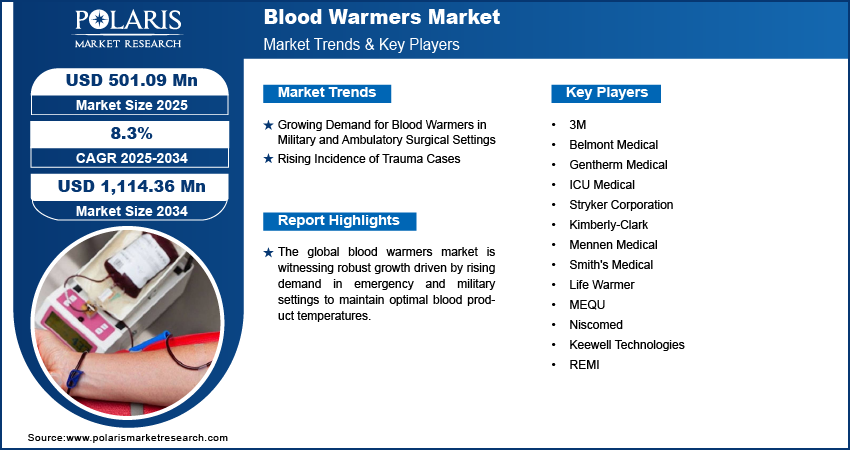The global blood warmers market is on a trajectory of significant growth, projected to reach USD 1,114.36 million by 2034, with a compound annual growth rate (CAGR) of 8.3% during the forecast period from 2025 to 2034. This growth is driven by various factors including advancements in technology, increasing surgical procedures, and a rising incidence of hypothermia among patients. This article delves into the market overview, key drivers, growth trends, challenges, opportunities, and other insights related to the blood warmers market.
Market Overview
Blood warmers are medical devices designed to heat blood and intravenous fluids to body temperature before administration. They play a crucial role in preventing hypothermia during surgeries and trauma care, ensuring that patients receive fluids at safe temperatures. The market for these devices has been expanding due to the increasing number of surgical procedures globally, alongside a growing awareness of the importance of maintaining normothermia in medical settings.In 2024, the global blood warmers market was valued at approximately USD 459.44 million and is expected to grow significantly in the coming years. The rise in surgical cases and trauma incidents has been a primary factor contributing to this growth. Additionally, advancements in warming technology have made these devices more effective and easier to use in various healthcare settings.
Some of the major players operating in the global market include:
- Gentherm Medical
- ICU Medical
- Stryker Corporation
- Kimberly-Clark
- Mennen Medical
- Smith’s Medical
- Life Warmer
- MEQU
- Niscomed
- Keewell Technologies
Key Drivers of Growth
- Increasing Surgical Procedures: The global increase in surgical operations is a significant driver for the blood warmers market. With an estimated 310 million surgeries performed annually worldwide, the demand for effective warming solutions is expected to rise correspondingly.
- Rising Incidence of Hypothermia: Hypothermia can occur during surgeries or trauma care when patients are exposed to cold environments or lose body heat rapidly. By warming blood and fluids before administration, healthcare providers can mitigate this risk and improve patient outcomes.
- Technological Advancements: Innovations in warming technologies, such as portable blood warmers and advanced infrared heating systems, have enhanced the efficiency and safety of these devices. These advancements are making blood warmers more accessible and easier to integrate into emergency medical services.
- Growing Prevalence of Chronic Diseases: The increasing number of patients requiring intravenous treatments due to chronic illnesses also contributes to the demand for blood warmers. Conditions such as cancer often necessitate frequent transfusions or infusions that require careful temperature management.
𝐄𝐱𝐩𝐥𝐨𝐫𝐞 𝐓𝐡𝐞 𝐂𝐨𝐦𝐩𝐥𝐞𝐭𝐞 𝐂𝐨𝐦𝐩𝐫𝐞𝐡𝐞𝐧𝐬𝐢𝐯𝐞 𝐑𝐞𝐩𝐨𝐫𝐭 𝐇𝐞𝐫𝐞:
https://www.polarismarketresearch.com/industry-analysis/blood-iv-warmers-market
Growth Trends
The blood warmers market is expected to witness several notable trends over the next decade:
- Shift Towards Portable Devices: There is a growing preference for portable blood warmers that can be used in various settings including ambulances and remote locations. This trend aligns with the increasing need for immediate medical response in emergencies.
- Integration with Healthcare Technologies: Blood warmers are increasingly being integrated with other medical technologies such as patient monitoring systems, enhancing their functionality and improving overall patient care.
- Focus on Patient Safety: As healthcare providers prioritize patient safety and comfort, there is an increasing emphasis on maintaining normothermia during medical procedures. This focus is driving innovations in blood warmer designs and features.
Challenges Facing the Market
Despite its promising growth trajectory, the blood warmers market faces several challenges:
- High Costs: The initial investment required for advanced blood warming systems can be substantial for healthcare facilities, particularly smaller clinics or those in developing regions. This cost barrier may limit widespread adoption.
- Regulatory Hurdles: The medical device industry is heavily regulated, which can slow down the introduction of new products into the market. Compliance with stringent regulations can pose challenges for manufacturers looking to innovate.
- Competition from Alternative Solutions: Other methods of maintaining body temperature during surgeries or trauma care may compete with blood warmers. These alternatives could include heated blankets or environmental controls that may be more cost-effective.
𝐒𝐞𝐠𝐦𝐞𝐧𝐭𝐚𝐥 𝐎𝐯𝐞𝐫𝐯𝐢𝐞𝐰:
The research report categorizes the market into various segments and sub-segments. The primary segments covered in the study include type, application, end use and region. The splitting of the market into various groups enables businesses to understand market preferences and trends better. Also, stakeholders can develop products/services that align with the diverse needs of consumers in the industry. Besides, the research study includes a thorough examination of all the major sub-segments in the market.
By Product Outlook (Revenue, USD Million, 2020–2034)
- Portable Blood/IV Warmer Device
- Non-portable Blood/IV Warmers
By Application Outlook (Revenue, USD Million, 2020–2034)
- Surgery
- Acute Care
- New Born Care
- Homecare
- Others
By End Use Outlook (Revenue, USD Million, 2020–2034)
- Hospitals/Clinics
- Ambulatory Services
- Defense Forces
- Rescue Forces
In conclusion, the global blood warmers market is poised for substantial growth driven by technological advancements, an increasing number of surgical procedures, and a heightened focus on patient safety. While challenges exist, numerous opportunities await manufacturers willing to innovate and adapt to changing healthcare needs. As this market evolves over the next decade, it will play a critical role in enhancing patient outcomes across various medical settings.

